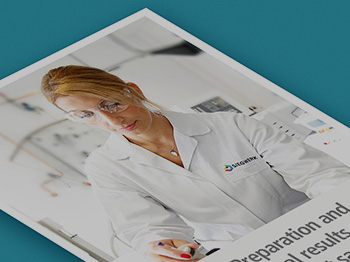Washable crystallizable PET shrink sleeves
to increase yield in PET bottle-to-bottle recycling
Together with our partners MCC and Klöckner Pentaplast, Siegwerk developed washable shrink sleeves based on crystallizable PET (cPET) as film printed with specially developed washable inks and primer solutions. This approach represents a massive upgrade with regard to the existing PET bottle recycling process as the cPET sleeves, being fully recyclable with the bottle flakes, will help to increase the yield and quality of rPET.
Sophisticated external and internal analytical testing confirms that the deinking process does not have any impact on the quality of the recovered PET recyclate and can be considered safe to use within the circular PET bottle recycling process requiring food grade rPET quality.

Introduction
Polyethylen terephthalate (PET) has been utilized in the beverage industry for many years, largely replacing other materials to become the most abundant plastic type in packaging materials globally. PET bottles have convincing advantages: they are light-weight and unbreakable, they show a low permeability for gases, moderate water vapor transmission rates and good mechanical properties.
Given the increased demand for reuse of packaging materials, PET bottles are increasingly made of post-consumer recyclates, and some bottles with 100% of recycled PET contents are already on the market. A great facilitator in this regard has been the development of “super-clean technologies” which can effectively remove molecular contaminants. This is a prerequisite for the reuse of recycled material in food application (e.g. for PET bottle recycling).
Crystallizable PET shrink sleeve labels for PET bottles
In the global market of product decoration and brand promotion, shrink sleeves are poised for significant growth rates, as they provide full 360°, top-to-bottom decoration for a broad variety of packaging types such as bottles, cups, trays, etc.
Consequently, shrink sleeves may help to reduce the need for mass-colored bottles. This helps to improve the quality of recycled bottle materials and supports a wider range of applications for the recyclate.
Shrink sleeves offer an effective labeling technology that combines high quality graphics with complex container geometries to maximize shelf appeal of FMCG (Fast Moving Consumer Goods) products.
In terms of volume PETG (glycol modified PET) film is currently the most abundant film type used for shrink sleeve labels in Europe and North America and has largely replaced PVC and Polystyrene based shrink sleeves.
Historically, when recycling PET containers labeled with full body shrink sleeves, it was crucial to completely remove the shrink sleeve material from the PET bottle recycling stream to avoid subsequent processing issues with the recycled PET due to material incompatibility.
While brand owners strive to see a 100% recyclability of their packaging material, current PETG shrink sleeves are considered a disruptor for the PET bottle recycling and have to be separated from the bottle PET stream. Given the trend of thin-walled PET bottles, this situation becomes even more problematic, as a quantitative mechanical separation of shrink sleeves also leads to increased losses of PET bottle recyclate in the separation process.
In order to avoid the need for material separation and thus improve the yield and quality of rPET, crystallizable PET (cPET) has been developed as a technically comparable alternative to PETG. In contrast to PETG, crystallizable PET is compatible with the PET bottle recycling stream and does not adversely impact the rPET-quality, enabling the recycling of both materials, the bottle PET and the cPET shrink sleeve simultaneously.
However, because the shrink sleeve is printed, it is necessary to remove the printing inks during the PET bottle recycling process to avoid problems like discoloration and chemical contamination of the recycled PET. In order to ensure complete ink removal from the shrink sleeve in the existing hot washing process, Siegwerk developed washable ink solutions for all relevant printing processes for shrink sleeves. These UV-curing and solvent-based inks and primers ensure a smooth deinking of cPET-based shrink sleeves during the usual washing conditions in the PET bottle recycling process and at the same time are non-bleeding to avoid any contamination of the washing water which might affect the rPET quality.
In order to test the technical feasibility of the concept, cPET in combination with washable inks, Siegwerk partnered with Klöckner Pentaplast and MCC to unlock the use of crystallizable PET shrink sleeves in Europe in the recycling of beverage PET bottles.
Compliance with FCM legislation and food-safety aspects of the bottle-to-bottle PET recycling process
Beverage companies that use PET bottles with recycled content for their products have to prove compliance with the European food contact material (FCM) legislations. It is essential to ensure that any substances migrating from the packaging material into the food do not harm the consumer.
Compliance with FCM legislation
Beverage companies that use PET bottles with recycled content for their products have to prove compliance with the European food contact material (FCM) legislations. These are the general requirements of the European “Framework Regulation” (EC) No 1935/2004 and the “Plastic Regulation” (EU) No 10/2011 as well as the demands of the “Recycled Plastic Regulation” (EC) No 282/2008. According to these regulations, several criteria must be met: no harm to human health, the Overall Migration Limit (OML) requirement of 10 mg/m2 of food contact area has to be met and (if applicable) the Specific Migration Limits (SMLs) as well as the safety requirements regarding Non-Intentionally Added Substances (NIAS) have to be fulfilled. Moreover, the process for the production of recycled PET needs to have received an EFSA opinion in favor of authorization[2].
Food-safety aspects of the bottle-to-bottle PET recycling process
It is essential to ensure that any substances migrating from the packaging material into the food do not harm the consumer. In the case of printed and deinked crystallizable PET shrink sleeve labels, which are recycled together with the PET bottles, an analytical screening after washing and the “super clean process” must be done to demonstrate the safety of the process. In this context, particular attention must be paid to the presence of any NIAS that still might be present in the recyclate and which could originate from the PET bottles as well as from other materials like printing inks. NIAS are chemical substances that, in contrast to IAS, are present in a packaging material but have not been added intentionally during the production process. NIAS can be by-products or impurities of starting substances as well as reaction or decomposition products. In the case of PET beverage bottles some NIAS are related to degradation or reaction side-products of additives or the polymer itself. Additionally, PET oligomers can be considered as NIAS either[1].
Samples and sample preparation
The main objective of this study was to confirm that there are no food safety risks regarding washable inks used on crystallizable PET shrink labels within a bottle-to-bottle recycling process. Against this background four PET recyclate samples, based on combined recycling of PET-bottles/printed cPET shrink sleeves, were analyzed in comparison to reference PET-bottles/unprinted cPET shrink sleeve samples, to determine the presence of NIAS after hot washing to remove the printing ink, and a “super clean process” to remove potential migrants.
Sample description
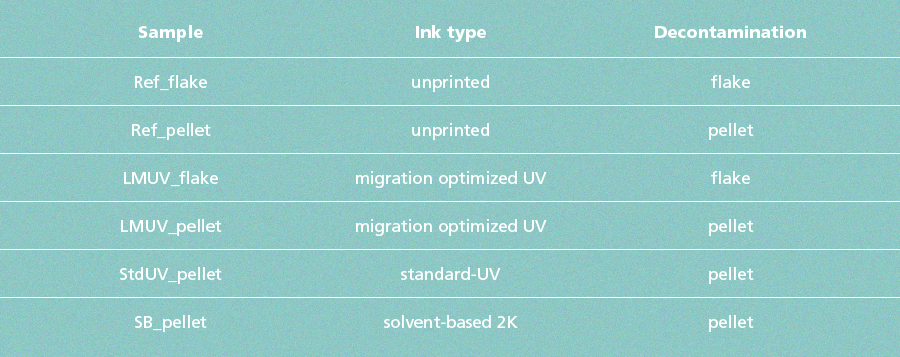
All samples (including the reference) had been hot-washed applying typical conditions used in the PET industry and after drying decontaminated via a “super-clean process”. In each case a ratio of 97/3 PET/cPET had been used as input material which represents a typical ratio of bottle to sleeve material.
Flow chart

Fraunhofer IVV results: Non-target screening of volatile compounds[5]
Each sample (in duplicate) was analyzed using headspace gas chromatography with flame ionization detection (FID).
All investigated samples were found to contain the typical PET degradation products acetaldehyde (CAS 75-07-0) and 2-methyl-1,3-dioxolane (CAS 497-26-7). In addition, traces of benzene (CAS 71-43-2) as well as the residual monomer ethylene glycol (CAS 107-21-1) were detected. It has to be pointed out, that benzene is most probably a degradation product from PVC impurities in the PET recycling stream and is present in trace amounts in all bottles with recycled content[2]. No substances resulting from the printing ink could be detected in the samples.
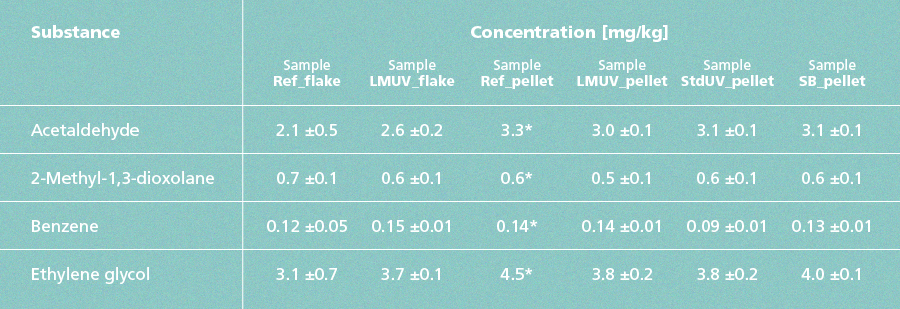
Table 1: Quantification of volatile substances in the investigated sample. Concentrations are given as mg/kg PET; *The results of these quantification are only single values, therefore no standard deviation can be given.
Fraunhofer IVV results: Non-target screening of semi-volatile compounds[5]
Each sample was extracted with dichloromethane by total immersion. These extraction solutions were analyzed by gas chromatography with flame ionization detection (GC-FID). The findings were that only PET typical oligomers, e.g. cyclic PET trimer (C30H24O12) up to cyclic PET hexamer (C60H48O24), were present whereas no substances resulting from the printing ink could be detected in the samples.
Fraunhofer IVV results: Targeted analysis of inorganic compounds, bisphenol A, phthalates and adipates[5]
Traces of these substances could be detected, but only in very low concentrations which are comparable to standard samples of recycled PET.
Bisphenol A as well as phthalate and adipate esters might be from ubiquitous sources whereas DEHP, DINP and DIDP can be used as technical support agents.
Migration modeling[2,3,4]
Migration research has shown that migration from the packaging material to food obeys Fick’s laws of diffusion and is therefore predictable and can be calculated using suitable software and appropriate, scientifically-based modeling parameters.
Migration is dependent on the molecular weight (or rather the molecular volume) of the migrant. Figure 1-6 show a correlation between the bottle wall concentration, which corresponds to a migration of 10 µg/kg (10 ppb) food after storage for 365 days at 25 °C and the molecular volume of the migrant (green curve). These concentrations were calculated for a PET container with a surface-volume ratio of 6 dm2 per 1 kg food, the so called “EU-cube”. As an additional safety factor, a deviation of 20 % on the molecular volume was considered (red line). The red dots in the assorted diagrams represent the concentration of the substances in each sample, which were detected in the above described screening tests.
It can be seen, that all of the experimental dots, except acetaldehyde and ethylene glycol, are well below the 10 µg/l curve, which is the migration limit for non-evaluated substances (provided that they are not classified as ‘mutagenic’, ‘carcinogenic’ or ‘toxic to reproduction’). This means, that the migration of these substances will be below 10 ppb after a storage time of 1 year at 25 °C.
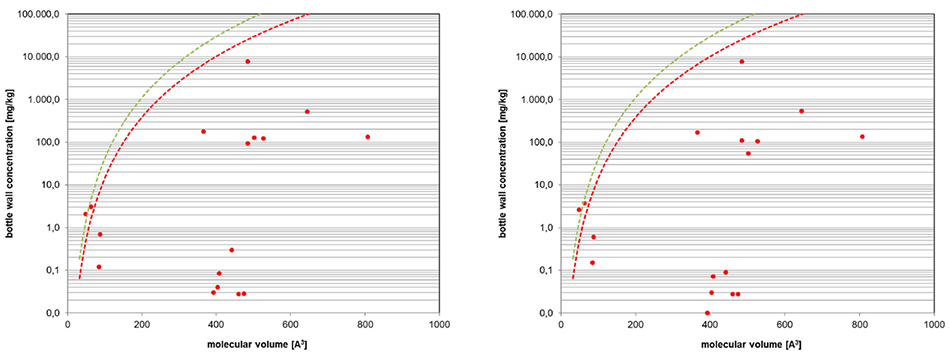
Fig. 1: Sample Ref_flake / Fig. 2: Sample LMUV_flake

Fig. 3: Sample Ref_pellet / Fig. 4: Sample LMUV_pellet
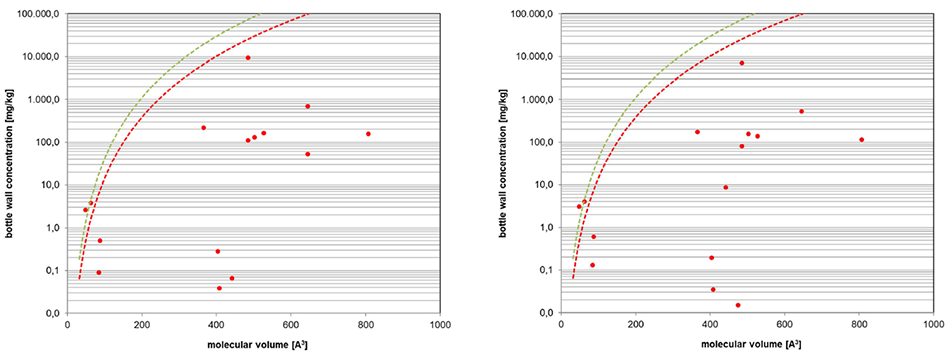
Fig. 5: Sample StdUV_pellet / Fig. 6: Sample SB_pellet
Figure 1-6[5]: Correlation between the bottle wall concentration which corresponds to a migration of 10 µg/kg food after storage for 365 days at 25 °C and the molecular volume of the migrant.
green line: predicted from molecular volume; red line: deviation of -20% on the molecular volume V (worst-case).
red dots: experimental data points of the different samples.
Acetaldehyde (FCM substance No 128) and ethylene glycol (FCM substance No 227) are listed in the Annex I of the Regulation 10/2011 with specific migration limits of 6 mg/kg and 30 mg/kg, respectively. Therefore, the above mentioned specific migration limits can be applied for these substances instead of 10 ppb.
Siegwerk analysis results
All six samples had also been analyzed by Siegwerk in a targeted analysis for printing ink components after an extraction in Ethanol for 3 days at ambient temperatures via GC/MS or LC/HRMS respectively. Additionally, as a comparison, a sample of a printed sleeve (which hadn´t been hot-washed, deinked and decontaminated) with the printing structure of LMUV_flake was analyzed. No printing ink ingredients could be detected in any of the samples that were originally printed either with one of the UV inks (LMUV_flakes, LMUV_pellet, StdUV_pellet) or the solvent-based ink (SB_pellets) by a detection limit of 1 ppm for most of the smaller molecules (MG < 240 g/mol) and 0.5 ppm for the others. On the other hand, all ink-related substances present in the printing structure printed with the LMUV-ink (LMUV_flakes) could be detected in the comparison sample of the printed sleeve. This clearly shows the efficiency of the washing and decontamination process.
In the extract analysis of the sample with the solvent-based printing ink structure (SB_flakes) only a few substances could be detected, namely Oleamide (CAS 301-02-0) and DOA (CAS 103-23-1)) but the concentration of these compounds was comparable to the unprinted sample (Ref_flakes). This indicates that these substances were present in the rPET substrate either. This assumption is further strengthened by the fact that no other printing ink specific substances such as paraffin waxes (CAS 8002-74-2) or trimethylolpropane (CAS 77-99-6) could be found. As Oleamide and DOA are listed in the Annex I of the Regulation 10/2011 as well with high migration limits of 60 mg/kg (OML) and 18 mg/kg, respectively, these substances are of no toxicological concern, even if they had been detected.
[5]: Test report Fraunhofer IVV: Screening analysis of non-intentionally added substances (NIAS) in PET, January 2021. Proprietary of Siegwerk, Klöckner Pentaplast and Multi-Color Corporation
Conclusion
Four samples of post-consumer PET bottle recyclates, which were recycled together with printed cPET shrink sleeve labels, have been analytically investigated regarding non-intentionally added substances (NIAS) after a “super clean process” following a hot-washing (deinking) step. The samples did not show any noticeable differences to standard PET bottle recyclates which have been recycled without printed labels in terms of NIAS. Only the typical PET degradation products and oligomers, and no substances originating from the printing ink, were detectable. Applying the established migration modeling model from F. Welle[3,4] shows that the expected migration of all non-evaluated substances into the beverage will be below 10 ppb after a storage time of 1 year and the recycling process can therefore be regarded as safe for the consumer.
Taking all this into consideration on the basis of the conducted study, Siegwerk´s washable ink solution can be considered a safe and economic opportunity to increase the recycling rate of PET by using cPET instead of PETG as sleeve material.
Useful Links & Literature
1. P. Schmid, F. Welle: Chemical Migration from Beverage Packaging Materials – A Review
3. F. Welle: Evaluation of non-intentionally added substances (NIAS) in PET bottles, 6th International Symposium on Food Packaging, November 2016, Barcelona
4. F. Welle: A new method for the prediction of diffusion coefficients in poly(ethylene terephthalate). Journal of Applied Polymer Science 2013, 129(4), 1845-1851
Deinking
A Dr. Stefan Häp, Head of Technology and Innovation BOC at Siegwerk, explains the deinking process
B Deinking explained easily



